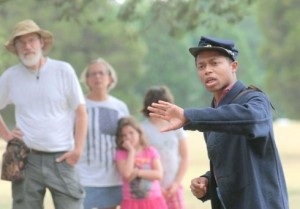 As I make my way through my manuscript on historical memory one last time before sending it in, I am reminded of the dramatic changes that have taken place in the way we remember and commemorate the battle of the Crater. Much of that change has taken place over the past forty years as a result of the Civil Rights Movement. Before 1970 you would be hard pressed to find references to the story of USCTs in both written accounts and in the way the battlefield itself was interpreted. My manuscript ends with a few reflections about the Civil War Sesquicentennial, but when I peer into the future it is this image that I see. This is a photograph of Emmanuel Dabney, who works as a park ranger at the Petersburg National Battlefield. He is a native of Dinwiddie County and has fully embraced its rich history. Emmanuel has a degree in Historic Preservation from the University of Mary Washington and recently completed an advanced degree at the University of North Carolina at Greensboro. If Emmanuel has his way he will spend his career educating the public at PNB.
As I make my way through my manuscript on historical memory one last time before sending it in, I am reminded of the dramatic changes that have taken place in the way we remember and commemorate the battle of the Crater. Much of that change has taken place over the past forty years as a result of the Civil Rights Movement. Before 1970 you would be hard pressed to find references to the story of USCTs in both written accounts and in the way the battlefield itself was interpreted. My manuscript ends with a few reflections about the Civil War Sesquicentennial, but when I peer into the future it is this image that I see. This is a photograph of Emmanuel Dabney, who works as a park ranger at the Petersburg National Battlefield. He is a native of Dinwiddie County and has fully embraced its rich history. Emmanuel has a degree in Historic Preservation from the University of Mary Washington and recently completed an advanced degree at the University of North Carolina at Greensboro. If Emmanuel has his way he will spend his career educating the public at PNB.
In many ways, Emmanuel is a big part of the story that I tell about the Crater. On the one hand, the fact that he is African American situates him at a crucial moment in the overall life of the battlefield and our broader understanding of the Civil War. At the same time Emmanuel has been a huge help to me throughout the research and writing process. Even this past weekend he helped to track down information about one of the Crater’s wayside markers. One of the joys of working on this project has been the opportunity to meet people, like Emmanuel, who share my passion for history and education.
[Photograph from Petersburg Progress-Index]
In 2011 I did a driving tour with friends visiting Civil War battlefields, mostly in Virginia. We had the privilege of taking the Petersburg battle tour with Mr. Dabney and then followed with his tour of the Crater. He’s one of the best interpreters of history I’ve encountered in my travels.
Check this out – http://thelintinmypocket.wordpress.com/2010/07/30/anniversary-of-the-battle-of-the-crater-boom/
Thank you Kevin for this kind post. I will remain a force to recounting the various experiences of all people: men, women, children; black and white; free or enslaved; North or South and I welcome the various readers of the blog to come to Petersburg National Battlefield. To repeat a trope, but a true one: the parks belong to the American people and its various foreign visitors and are one of the greatest ideas of the country.
In response to Mr. Epperson (and perhaps others curious), the battlefield completed in 2005 our General Management Plan. This includes the plan that 7,238 acres of additional lands be acquired in the future for the battlefield. The breakdown for the battlefields:
Boydton Plank Road-99 acres
Crater-15 acres
Five Forks-1,047 acres
Fort Stedman/Picket Line Attack-879 acres
Globe Tavern-611 acres
Hatcher’s Run-1,710 acres
Jerusalem Plank Rd.-222 acres
Peebles Farm-88 acres
Petersburg-The Assault-95 acres [Note: Lands associated with June 15-18, 1864 fighting.]
Petersburg-The Breakthrough- 33 acres
Reams Station-506 acres
White Oak Road-1,925 acres
Pecan & Water Street-1 acre
Poplar Grove National Cemetery Road- 4 acres
Water Street- 2 acres
Winfield Road- 1 acre
In the next ten years or so, we expect that the GMP will finally pass on through the halls of Congress and lands protected by various partners will come into the folds of the NPS. This will allow preservation groups to buy more land around Petersburg and elsewhere. So stay tuned to Petersburg!
Wow, what a photograph. This would be great for a discussion starter in my classroom.
I have been impressed, in recent visits to PNB, with how it has changed from my first serious visit in the late 70s. But they need to do a lot more, like develop and interpret Fort Gregg and Fort Fisher and the Globe Tavern area.